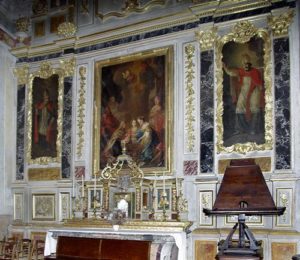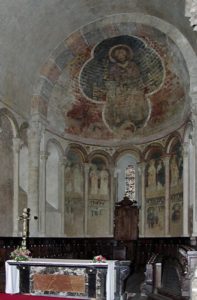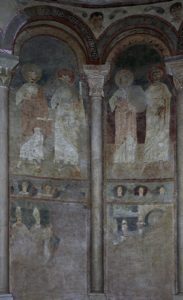The Cathedral of St Girons with its hexagonal bell tower dominates the lower town of St Lizier.
The original building was 10thC but was damaged during the 12thC and had to be rebuilt. The octagonal bell tower dates from 1300 although the crenelations are modern. The doorway is 15thC. Inside there are frescoes dating from 11th-14thC.
The hexagonal bell tower over the transept has two tiers of pointed bell windows. It has a tall windowless nave with big buttresses. The transepts are lower and the rose windows have been blocked up. The apse at the east end is lower and has carved corbels with even lower apses on either side.
There are few windows so the inside of the church is quite dark. A 50c coin operated light switch provided light in the apse and on the south transept reredos. This is worth while, especially for the frescoes in the apse.
Inside there is a large nave with a vaulted ceiling, transepts with altars and reredos and a balcony at the west end with a carved wooden organ. There are two side altars on the nave walls.
Multi-angular wall pillars in the nave with a carved frieze at the top lead to the ribs of the vaulted ceiling. These are painted in bands of yellow and red or blue, red and yellow. The ceiling between the ribs is marked out in bricks with a red motif in the centre. The nave wall between the pillars has large blank rounded arches and the two nave altars are in the arches nearest the chancel.
Pillars with ‘water flower’ capitals lead to the chancel arch which is painted in bands of red and blue. Don’t miss the carved feet at the base of the pillars. The huge rounded chancel has a free standing altar with two rows of choir stalls round the walls. These have carved arms and misericords. in the centre is the Bishops chair. There is an arcade of blind Romanesque arches above the choir stalls. The only light is from three small Romanesque windows set into the arches. Side pillars with carved ‘water flower’ leaf capitals partially obscure the arcading and continue to form a rib across the ceiling. this is painted in red and blue blocks. Beyond is a 13/14thC fresco of Christ in Majesty, surrounded by the symbols of the evangelists.
The 2 blind arches on either side of the central window have 11thC frescoes. There are two images in each arcade which are separate by a narrow band with painted heads. At the top are images of the apostles. Below on the right, are scenes of the Annunciation and the Visitation with Mary and Elizabeth cheek to cheek with fused haloes. On the left at the bottom are the three Magi with Herod and also at the manger.
The inside of the arches is decorated with a scroll pattern. There is another decorative painted border above the arches and tiny painted heads at the corners.
The small Romanesque south apse has big carved capitals under a round arch and has a statue of the Virgin and child. The north apse is used as a general storage area with big candle sticks, chairs, choir robes…
The chapel at the end of the north transept has a marble altar with a huge reredos which covers the whole wall, explaining why the rose window has been blocked. Above the alter is an elaborate host box with cherub heads set in a gilded cupola with pillars and gilded flowers. This has an orb and cross on the top. On either side are painted panels with a gilded head of Mary and another of Jesus with a crown of thorns. These are set in grey and gilt frames. Above is a huge oil painting in a gilt frame of Mary with the Baby Jesus and the women with cherubs above. On either side is a painting of a bishop in an elaborate gilt frame. On either side are dark marble pillars with gilded capitals And decorative hanging garlands of gilt flowers. At the top is a huge gilded monstrance set in a portico with gilded arches and surrounds. The side walls of the transept are painted to resemble marble. There are two round topped windows with cherubs above them.
The south transept has a marble altar with a very elaborate gilt host box decorated with cherub heads and a rather wonky cross on the top. There is a massive reredos with dark marble pillars with elaborately carved white marble tops. In the centre is a 17thC gilded pieta with a long swirling cloud above it. The pillars support a semi-circular portico with carved cherubs and more swirling clouds leading to the back wall and partially obscuring a sun burst. On either side of the altar, standing on pedestals are marble statues of Joan of Arc and St Theresa. The walls are covered with panels painted to resemble marble and the ceiling is painted with outlines of bricks. There is no window on the west wall, just a painted window under carved cherub heads.
The south nave altar is painted with marble panels. Above the host box is a statue of a bishop in gilded robes with a mitre and crook. On either side are two painted dark marble pillars which support a black and white semi-circular portico with a red triangle on a yellow background surrounded by a ring of clouds and sun rays. On the top rare angels and a cross.
The north nave altar is similar but has grey and red painted marble pillars with a painting in the centre of Christ holding a cross and with a dove (Holy Spirit) above him and four figures kneeling at his feet. Above i a Triangular portico with painted urns at the corners with flames at the to. In the centre is a cross with two cherub heads.
On the west wall under the balcony are two wall mounted fragments of frescoes. One has part of an angel with green wings. The other has a group of figures looking upwards. There are statues of St Joseph and the boy Jesus and St Antonine de Padua.
The Cloisters are reached through a wooden door at the back of the south wall, which was held closed by a chair to keep out the cold air.
The 12th and 13thC cloisters have an open arcade of double and single round pillars with carved capitals supporting round arches. Capitals include ‘water flowers’ scrolls, swirls and figures. Above the cloister is another arcade added in the 16thC with rectangular openings. This is reached by a wooden stairway in the south west corner but the gate at the bottom was locked. We could see tantalising glimpses of frescoes on the walls of the upper arcade.
There are wall niches with tombs round the walls of the cloister. On the west wall is the tomb of Bishop Hector d’Ossun 1548-74. On the south wall is a niche with a carved Gothic arch above. On the back wall is a painting of Christ on the cross with Mary Magdalene at his side. On the east wall is a stone sarcophagus, carved stone trough and a wall niche with the tomb f a bishop with a Latin inscription underneath. The north wall has a recess set in an elaborate Gothic arch with a central pillar.
This was an excellent visit. It is a lovely church with some splendid reredos. The frescoes were a real plus.










